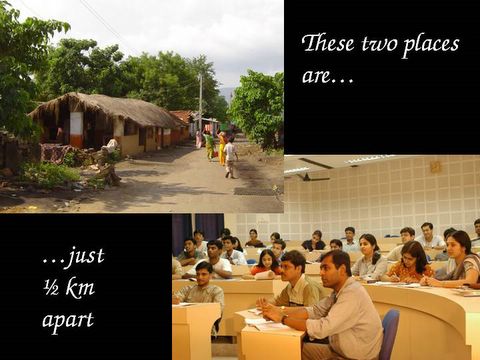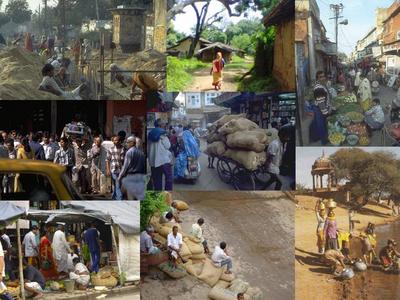Sometime in the last century, Adam Smith was hijacked, gagged, and new words were forced into his mouth!
The hijacking of the 300-year old dead Scotish economist happened, when in 1948, I believe (or so I read somewhere), he got misquoted in Paul Samuelson's Textbook of Economics. That perhaps, was the first time the theory of "invisible hand" of the free-market got articulated. The so-called "quote" from Adam Smith's An Inquiry into the Nature And Causes of the Wealth of Nations (1776), reads:
"It is not from the benevolence of the butcher, the brewer, or the baker that we expect our dinner, but from their regard to their own interest. We address ourselves, not to their humanity but to their self-love, and never talk to them of our own necessities but of their advantages.
Every individual endeavours to employ his capital so that its produce may be of the greatest value. He generally neither intends to promote the public interest, nor knows how much he is promoting it. He intends only his own security, only his own gain. And he is in this led by an invisible hand to promote an end which was no part of his intention. By pursuing his own interest he frequently promotes that of the society more effectually than he really intends to promote it."
This (mis)quotation from Adam Smith, which has been so often repeated (by politicians, media, adademics, policy-planners) that it has become an underlying - a dogma/ ideology - of our present flavour-of-the-day global economic system. It helps justifying the unregulated "free-market" ideology, globalisation, the doctrine of "self-interest"/limitless-greed, and the irrelevance of state/government in promoting public good.
The only problem is that this is not exactly what Adam Smith had ever said!!!
What Did Adam Smith Say?
The Book IV/Chapter 2/Para 10/Line 2 of Wealth of Nations gives the full quote:
"As every individual, therefore, endeavours as much as he can both to employ his capital in the support of domestic industry, and so to direct that industry that its produce may be of the greatest value; every individual necessarily labours to render the annual revenue of the society as great as he can. He generally, indeed, neither intends to promote the public interest, nor knows how much he is promoting it. By preferring the support of domestic to that of foreign industry, he intends only his own security; and by directing that industry in such a manner as its produce may be of the greatest value, he intends only his own gain, and he is in this, as in many other cases, led by an invisible hand to promote an end which was no part of his intention. Nor is it always the worse for the society that it was no part of it. By pursuing his own interest he frequently promotes that of the society more effectually than when he really intends to promote it."
http://www.adamsmith.org/smith/won-b4-c2.htm
It is, indeed, perhaps more than a coincidence that the popular version of Smith's (mis)quote, completely misses out his views about the individual employing his capital "in the support of domestic industry" or preferring "the support of domestic to that of foreign industry."...
According to the full quotation, Adam Smith was actually saying that investment in domestic industry and its produce - i.e., localisation not globalisation - promotes the "public good"... He was, actually, promoting a sort of economic nationalism!!!
What Else Did Adam Smith Say?
There are many other things that Adam Smith wrote, which are also never mentioned or highlighted. Some of his other observations, that are carefully never mentioned:
On "State vs. Business" Issue: Lesser of the Two Evils!
http://www.adamsmith.org/smith/won-b4-c3-pt-2.htm
On Industry/Trade Associations/Forums
http://www.adamsmith.org/smith/won-b1-c10-pt-2.htm
On Nature of Sustainable Nature of Wealth:
http://www.adamsmith.org/smith/won-b5-c2-pt-1.htm
On Corporation & Corporate Governance
http://www.adamsmith.org/smith/won-b1-c10-pt-2.htm
On "Export-Led" Economies
http://www.adamsmith.org/smith/won-b3-c1.htm
On Bilateral Trade Agreements
http://www.adamsmith.org/smith/won-b4-c6.htm
etc. etc.
To be sure, Adam Smith was not against free-market. However, his definition of "free-market" was quite different (in many ways, opposite) than what is attibuted to him nowadays.
A couple of years back, I had made a posting on this blog entitled: Capitalism contradicts Free Market!!! I am reproducing it again:
We normally use the term capitalism and free-market in the same breath -- in fact, often interchangeably.
If one really thinks about it, the "Free Market Capitalism" (or "Capitalistic Free Market") is a contradiction in terms. Capitalism is based on an economic doctrine which concentrates the power to a few., while Free Market is based on assumption of equal distribution of power across markets.
Also Adam Smith's Free Market Theory was based on some assumptions:
(1) player are not large enough to influence the market dynamics
(2) there are no "information assymetries" (or trade secrets)
(3) trade across nations/ regions is balanced
(4) sellers are also producers, etc.
Clearly, none of these holds in the present day real world: World's largest 200 corporations earn sales revenues which are greater than the combined GDPs of 48LDCs; IPR regime blocks free flow of information; trade barriers and subsidies by richer nations do not allow balanced trade across regions, and sellers are often out-sourcers... etc.
So one can either support capitalism or support free market!!!
























